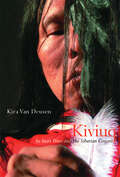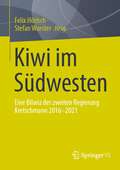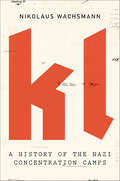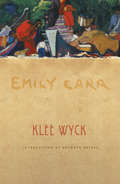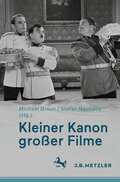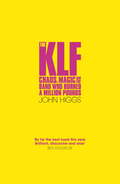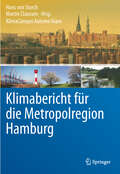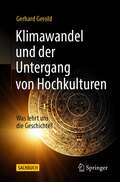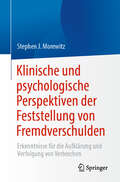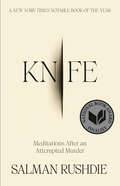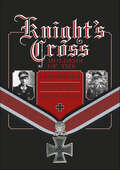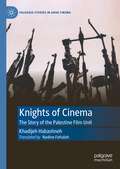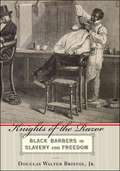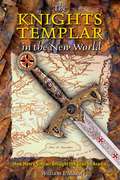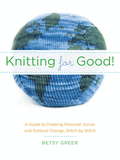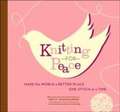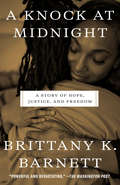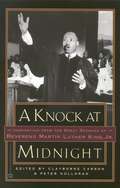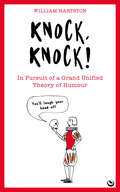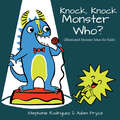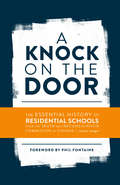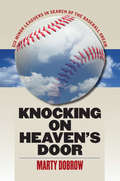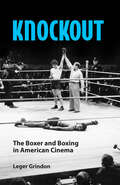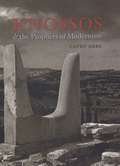- Table View
- List View
Kiviuq: An Inuit Hero and His Siberian Cousins (McGill-Queen's Indigenous and Northern Studies #54)
by Kira Van DeusenAfter decades exploring Siberian cultures, Kira Van Deusen turned to the Canadian north to ask many such questions, looking at them through the versions of one of their most respected legends - that of hero/shaman Kiviuq, an Inuit counterpart to Homer's Odysseus - told by forty Inuit elders. The elders' voices engage us directly, inviting us to look at the unique qualities of arctic heroism and its application to present-day concerns. Rich details from each of the elders' families help explain interpersonal challenges to survival in the north and offer both practical and spiritual lessons. Van Deusen also points out intriguing cultural connections across the Bering Strait, past and present.
Kiwi im Südwesten: Eine Bilanz der zweiten Regierung Kretschmann 2016-2021
by Felix Hörisch Stefan WursterNach der ersten grün-roten Landesregierung in einem deutschen Bundesland von 2011 bis 2016 in Baden-Württemberg führte Winfried Kretschmann von 2016 bis 2021 zum zweiten Mal eine grün-geführte Landesregierung an – eine lagerübergreifend grün-schwarze Kiwi-Koalition. Auch diese Regierungskonstellation ist bislang in der deutschen Geschichte einmalig. Der Sammelband analysiert, wie sich dieser Regierungswechsel von Grün-Rot zur selbst ernannten grün-schwarzen Komplementärkoalition in den verschiedenen Politikfeldern auf die durchgesetzten Policies ausgewirkt hat. Neben dem expliziten Vergleich der durchgeführten Reformen in den beiden Legislaturperioden beleuchten einzelne Kapitel des Sammelbands beispielsweise auch die Koalitionsbildungsprozesse, die Bürgerbeteiligung und den Einfluss organisierter Interessen unter der zweiten Landesregierung Kretschmann sowie die Verschiebungen im Parteiensystem in Baden-Württemberg.
KL: A History of the Nazi Concentration Camps
by Nikolaus WachsmannThe “deeply researched, groundbreaking” first comprehensive history of the Nazi concentration camps (Adam Kirsch, The New Yorker).In a landmark work of history, Nikolaus Wachsmann offers an unprecedented, integrated account of the Nazi concentration camps from their inception in 1933 through their demise, seventy years ago, in the spring of 1945. The Third Reich has been studied in more depth than virtually any other period in history, and yet until now there has been no history of the camp system that tells the full story of its broad development and the everyday experiences of its inhabitants, both perpetrators and victims, and all those living in what Primo Levi called “the gray zone.”In KL, Wachsmann fills this glaring gap in our understanding. He not only synthesizes a new generation of scholarly work, much of it untranslated and unknown outside of Germany, but also presents startling revelations, based on many years of archival research, about the functioning and scope of the camp system. Closely examining life and death inside the camps, and adopting a wider lens to show how the camp system was shaped by changing political, legal, social, economic, and military forces, Wachsmann produces a unified picture of the Nazi regime and its camps that we have never seen before.A boldly ambitious work of deep importance, KL is destined to be a classic in the history of the twentieth century.Praise for KLA Wall Street Journal Best Book of 2015A Kirkus Reviews Best History Book of 2015Finalist for the National Jewish Book Award in the Holocaust category“[A] monumental study . . . a work of prodigious scholarship . . . with agonizing human texture and extraordinary detail . . . Wachsmann makes the unimaginable palpable. That is his great achievement.” —Roger Cohen, The New York Times Book Review“Wachsmann’s meticulously detailed history is essential for many reasons, not the least of which is his careful documentation of Nazi Germany’s descent from greater to even greater madness. To the persistent question, “How did it happen?,” Wachsmann supplies voluminous answers.” —Earl Pike, The Plain Dealer (Cleveland)
Klee Wyck
by Emily Carr Kathryn BridgeDouglas & McIntyre is proud to announce definitive, completely redesigned editions of Emily Carr's seven enduring classic books. <P><P>These are beautifully crafted keepsake editions of the literary world of Emily Carr, each with an introduction by a distinguished Canadian writer or authority on Emily Carr and her work.Emily Carr's first book, published in 1941, was titled Klee Wyck ("Laughing One"), in honour of the name that the Native people of the west coast gave to her. This collection of twenty-one word sketches about Native people describes her visits and travels as she painted their totem poles and villages. Vital and direct, aware and poignant, it is as well regarded today as when it was first published in 1941 to instant and wide acclaim, winning the Governor General's Award for Non-fiction. In print ever since, it has been read and loved by several generations of Canadians, and has also been translated into French and Japanese.Kathryn Bridge, who, as an archivist, has long been well acquainted with the work of Emily Carr, has written an absorbing introduction that places Klee Wyck and Emily Carr in historical and literary context and provides interesting new information.
Kleiner Kanon großer Filme
by Michael Braun Stefan NeuhausWas macht einen Film groß? Für Truffaut war es niemals das ‚Runde‘ oder ‚Perfekte‘, Peter Hamm ergänzte, dass das Vergnügen des Kritikers oft da anfange, wo das der anderen aufhöre, bei Stilbrüchen etwa oder Exzessen. Was sind überhaupt Gründe dafür, bestimmte Filme besonders sehenswert zu finden? Die von Literatur-, Film- und Kulturwissenschaftler:innen geschriebenen Beiträge dieses Bands präsentieren je einen Film und begründen ausführlich, weshalb gerade er zu den größten der Geschichte gehört. Die Auswahl ist weder exklusiv noch elitär, sie regt zum Nachdenken an, weshalb uns auch Filme jenseits des Blockbuster-Kinos und der gängigen Kanonlisten in den Bann schlagen. Inmitten bekannter Klassiker von Lang, Chaplin, Hitchcock & Co. und jüngerer Meisterwerke von Haneke, Almodóvar und Sofia Coppola gibt es manchen Geheimtipp zu entdecken.
The KLF: Chaos, Magic and the Band who Burned a Million Pounds
by John Higgs'By far the best book this year, brilliant, discursive and wise' BEN GOLDACRE. The strange tale of the death, life and legacy of the hugely successful band.They were the bestselling singles band in the world. They had awards, credibility, commercial success and creative freedom. Then they deleted their records, erased themselves from musical history and burnt their last million pounds in a boathouse on the Isle of Jura. And they couldn't say why.This is not just the story of The KLF. It is a book about Carl Jung, Alan Moore, Robert Anton Wilson, Ken Campbell, Dada, Situationism, Discordianism, magic, chaos, punk, rave, the alchemical symbolism of Doctor Who and the special power of the number 23.Wildly unauthorised and unlike any other music biography, THE KLF is a trawl through chaos on the trail of a beautiful, accidental mythology.
Klimabericht für die Metropolregion Hamburg
by Hans Von Storch Martin ClaussenDer Sachstandsbericht liefert einen Überblick über das wissenschaftlich gesicherte Wissen zu Klima, Klimavariabilität und Klimawandel in der Region Hamburg. Dabei beschreiben die Autoren sowohl das Wissen über die letzten 100 Jahre als auch über mögliche Veränderungen in den kommenden 100 Jahren. Es wird dargestellt, auf welchen Feldern Übereinstimmung besteht, wo Uneinigkeit oder Unwissen herrschen und wo Forschungsbedarf besteht. Der Bericht wurde im Rahmen des Exzellenzclusters CliSAP am KlimaCampus der Universität Hamburg erarbeitet.
Klimawandel und der Untergang von Hochkulturen: Was lehrt uns die Geschichte?
by Gerhard GeroldGlobale Klimaveränderung und Klimakollaps sind in Medien und Gesellschaft ein inzwischen viel beachtetes Thema geworden. Der Zusammenbruch alter Hochkulturen wird dabei in Verbindung mit plötzlichen Klimaveränderungen gebracht. Anhand neuester Forschungsergebnisse gibt das Buch Antworten auf die Rolle von Klimaveränderung für den Kollaps alter Hochkulturen zu unterschiedlichen Zeiten und Kontinenten – von Mesopotamien bis nach Grönland. Dabei erfolgt eine Zusammenschau von archäologischen und paläoklimatischen Erkenntnissen unter Berücksichtigung der damaligen ökonomischen, politischen und religiös-kulturellen Verhältnisse. Der Geograph Gerhard Gerold legt mit diesem Buch eine detaillierte Analyse der schon in historischer Zeit bestehenden komplexen Vernetzung kulturgeschichtlicher und umweltökologischer Bedingungen vor, die für unsere heutige globalisierte Welt eine große Aktualität besitzen. Das Buch bietet zahlreiche Beispiele für den Vergleich damaliger und heutiger Umweltkrisen. Der Autor: Gerhard Gerold gehört als Mitglied der Nationalen Akademie der Wissenschaften Leopoldina zu den Wissenschaftlern, die sich schon seit den 80er Jahren mit Themen der Umweltzerstörung in den Tropen beschäftigt haben. Der Zusammenbruch früher Hochkulturen in Verbindung mit regionalen Klimaänderungen faszinierten ihn im Rahmen seiner umfangreichen geoökologischen Forschungsarbeiten.
Klinische und psychologische Perspektiven des Foulspiels
by Stephen J. MorewitzDieses Buch untersucht ein breites Spektrum von Faktoren, die Einfluss darauf haben können, wie die Polizei das Fremdverschulden in möglichen Mordfällen und bei anderen möglichen Verbrechen feststellt. Es wird eine neue Theorie der Unsicherheit auf der Mikro-, Meso- und Makroebene entwickelt, um zu erklären, wie Juristen zu dieser Entscheidung gelangen. Insbesondere wird untersucht, inwieweit die Unsicherheit in diesen Situationen durch die Medienberichterstattung, den Druck der Familie und der Gemeinschaft, sozioökonomische Faktoren, demografische Elemente der Opfer sowie das Wissen und die Ressourcen der Polizei beeinflusst werden kann. Dieses Buch beschreibt, wie forensische Fachleute die Strafverfolgungsbehörden in Fragen wie der Inszenierung von Tatorten zur Verschleierung des Vorsatzes, der Einleitung von Gemeinschaftsstrategien zur Suche nach vermissten Personen und der Zuverlässigkeit von Verhaltensprofilen beraten können. Die neuesten Forschungsergebnisse aus dem Foul Play Project und dem Missing Persons Project werden herangezogen, um die Empfehlungen in diesem Buch zu untermauern und den Weg für weitere Forschungen in diesem Bereich zu weisen.
Kneelers: The Unsung Folk Art of England and Wales
by Elizabeth BinghamA charming and witty history of the quirky - but surprisingly widespread - craft of embroidering kneeler cushions. The perfect gift book this Christmas, for those who love kneelers and those who don't!'A lovely look at a not-quite-vanishing craft that lies, literally, below our knees ... Inventive and interesting' The Oldie, 'Best Reads for All Ages This Christmas''A treasure of a collection' Amber Butchart, of BBC's The Great British Sewing Bee'I think I may already have discovered the best non fiction book of 2023' Reverend Richard Coles, author of A Murder Before EvensongKneelers is a celebration of the most widely practised - but often overlooked - folk art in England and Wales over the past ninety years: the design and craft of church kneelers. Featuring charming stories and enchanting designs from churches across the country, the book traces the history of kneelers; from their spectacular beginnings at Winchester in the 1930s to their booming popularity after Queen Elizabeth II's coronation and the present-day congregations who are keeping the tradition alive.In their range and diversity, the kneelers collected here form a fascinating social record of the concerns and interests that occupied their makers - including local fauna and flora, cricket, dragons, post-war tributes and the thrills of high-speed travel.Filled to the brim with beautiful full-colour images, Kneelers displays the quirky artistry and widely varied (and often surprising) motifs which have characterised church kneelers in the twentieth century. It rejoices in the personal stories of some of the people who have practised and advanced the art form, and is a wonderful commemoration of what happens when communities come together to celebrate their history and their environment.'A glorious and delightful salute' Tracy Chevalier, author of A Single Thread'This book is a Godsend!' Alan Titchmarsh, author of The Gardener's Almanac
Knife: Meditations After an Attempted Murder
by Salman RushdieNATIONAL BOOK AWARD FINALIST • #1 NATIONAL BESTSELLER • From Booker Prize winner Salman Rushdie, a searing, deeply personal account of enduring—and surviving—an attempt on his life thirty years after the fatwa that was ordered against himA BEST BOOK OF THE YEAR: The New York Times Book Review, The New Yorker, Time, NPR, Town & Country, New York Post, Chicago Public Library, Kirkus ReviewsOn the morning of August 12, 2022, Salman Rushdie was standing onstage at the Chautauqua Institution, preparing to give a lecture on the importance of keeping writers safe from harm, when a man in black—black clothes, black mask—rushed down the aisle toward him, wielding a knife. His first thought: So it&’s you. Here you are. What followed was a horrific act of violence that shook the literary world and beyond. Now, for the first time, and in unforgettable detail, Rushdie relives the traumatic events of that day and its aftermath, as well as his journey toward physical recovery and the healing that was made possible by the love and support of his wife, Eliza, his family, his army of doctors and physical therapists, and his community of readers worldwide. Knife is Rushdie at the peak of his powers, writing with urgency, with gravity, with unflinching honesty. It is also a deeply moving reminder of literature&’s capacity to make sense of the unthinkable, an intimate and life-affirming meditation on life, loss, love, art—and finding the strength to stand up again.
Knight's Cross Holders of the Fallschirmjager: Hitler’s Elite Parachute Force at War, 1940-1945
by Jeremy DixonMini-biographies of the 130 Knight&’s Cross Holders of the Fallschirmjäger, Hitler&’s elite paratroopers
Knights of Cinema: The Story of the Palestine Film Unit (Palgrave Studies in Arab Cinema)
by Khadijeh HabashnehThis book consists of an account of the creation of the Palestine Film Unit (PFU) and its founding members, from the photography department in the early years of the Palestinian revolution (1967-1968), to its evolution in the mid-1970’s into the Palestinian Cinema Institution. Khadijeh Habashneh weaves her own memories into excerpts from letters and other communications of survivors, friends and PFU family members, with writings by scholars who analyzed the work and the contributions of this remarkable film movement (from the late 1960’s to early 1980’s). As such it offers a unique perspective on this aspect of Palestine film history that ended in the loss of its archive in the mid 1980’s, providing details that have not been previously published in English.
Knights of the Razor: Black Barbers in Slavery and Freedom
by Douglas W. Bristol Jr.Black barbers, reflected a freed slave who barbered in antebellum St. Louis, may have been the only men in their community who enjoyed, at all times, the privilege of free speech. The reason lay in their temporary—but absolute—power over a client. With a flick of the wrist, they could have slit the throats of the white men they shaved. In Knights of the Razor, Douglas Walter Bristol, Jr., explores this extraordinary relationship in the largely untold story of African American barbers, North and South, from the American Revolution to the First World War. In addition to establishing the modern-day barbershop, these barbers used their skilled trade to navigate the many pitfalls that racism created for ambitious black men. Successful barbers assumed leadership roles in their localities, helping to form a black middle class despite pervasive racial segregation. They advocated economic independence from whites and founded insurance companies that became some of the largest black-owned corporations.
The Knights Templar in the New World: How Henry Sinclair Brought the Grail to Acadia
by William F. MannUses the principles of sacred geometry, archaeological evidence, and Native American legend to discover the site of a secret Templar settlement in Nova Scotia• Offers evidence that Scottish prince Henry Sinclair not only sailed to the New World 100 years before Columbus, but that he also established a refuge there for the Templars fleeing persecution• Shows that the Grail, the holy bloodline connecting the House of David to the Merovingian dynasty through Jesus and Mary Magdalene, was hidden in the New WorldIn 1398, almost 100 years before Columbus arrived in the New World, the Scottish prince Henry Sinclair, Earl of Orkney, sailed to what is today Nova Scotia, where his presence was recorded by Micmac Indian legends about Glooskap. This was the same Prince Henry Sinclair who offered refuge to the Knights Templar fleeing the persecution unleashed against the order by French king Philip the Fair at the beginning of the 14th century. With evidence from archaeological sites, indigenous legend, and sacred geometry handed down by the Templar order to the Freemasons, author William F. Mann has now rediscovered the site of the settlement established by Sinclair and his Templar followers in the New World. Here they found a safe refuge for the Grail--the holy bloodline connecting the House of David to the Merovingian Dynasty through the descendants of Jesus and Mary Magdalene--until the British exiled all the Acadians in 1755.
Knitting for Good!: A Guide to Creating Personal, Social, and Political Change Stitch by Stitch
by Betsy GreerEvery time we knit, we have the opportunity to create positive change in ourselves, our community, and in the world. That's Betsy Greer's fervent belief, and in this book she shows us how. Betsy explores the ways we can use knitting to slow down in a fast-paced culture, while using the craft to benefit charities in our communities, to advocate for worthwhile causes, and to support individuals and communities across the globe. Filled with insights from knitters and crafters on how they use craft to benefit others, Knitting for Good! will get you thinking about knitting in a whole new way. To learn more about the author, visit her website: craftivism.com
Knitting for Peace: Make the World a Better Place One Stitch at a Time
by Betty ChristiansenAll across America, people are knitting for peace. In yarn shops and private homes, churches and synagogues, schools and even prisons, they meet on weekday evenings or weekend afternoons to knit afghans for refugees, mittens for the homeless, socks for soldiers, or preemie caps for AIDS babies. The tradition goes back as far as Martha Washington, who spearheaded knitting efforts for the soldiers of the Revolutionary War, and has seen a recent flourishing in what is nowadays called "charity knitting," "community knitting," or "knitting for others. " And whether it's for world peace, community peace, or peace of mind, today's various causes have the common goal of knitting the world into a better place one stitch at a time. "Knitting for Peace" is an exceptional book that celebrates the long heritage of knitting for others. It tells the stories of 28 contemporary knitting-for-peace endeavors, and features patterns for easy-to-knit charity projects such as hats, socks, blankets, and bears, plus a messenger bag emblazoned with the "Knitting for Peace" logo. Enlivened by anecdotal sidebars and quotations from both knitters and peacemakers, this inspiring book also includes everything readers need to know to start their own knitting-for-peace groups. Picture descriptions present.
A Knock at Midnight: A Story of Hope, Justice, and Freedom
by Brittany K. BarnettAn urgent call to free those buried alive by America&’s legal system, and an inspiring true story about unwavering belief in humanity—from a gifted young lawyer and important new voice in the movement to transform the system.NAMED ONE OF THE BEST BOOKS OF THE SUMMER BY USA TODAY AND NEWSWEEK • &“An essential book for our time . . . Brittany K. Barnett is a star.&”—Van Jones, CEO of REFORM Alliance, CNN Host, and New York Times bestselling author Brittany K. Barnett was only a law student when she came across the case that would change her life forever—that of Sharanda Jones, single mother, business owner, and, like Brittany, Black daughter of the rural South. A victim of America&’s devastating war on drugs, Sharanda had been torn away from her young daughter and was serving a life sentence without parole—for a first-time drug offense. In Sharanda, Brittany saw haunting echoes of her own life, both as the daughter of a formerly incarcerated mother and as the once-girlfriend of an abusive drug dealer. As she studied this case, a system came into focus: one where widespread racial injustice forms the core of America&’s addiction to incarceration. Moved by Sharanda&’s plight, Brittany set to work to gain her freedom. This had never been the plan. Bright and ambitious, Brittany was a successful accountant on her way to a high-powered future in corporate law. But Sharanda&’s case opened the door to a harrowing journey through the criminal justice system. By day she moved billion-dollar deals, and by night she worked pro bono to free clients in near-hopeless legal battles. Ultimately, her path transformed her understanding of injustice in the courts, of genius languishing behind bars, and the very definition of freedom itself.Brittany&’s riveting memoir is at once a coming-of-age story and a powerful evocation of what it takes to bring hope and justice to a system built to resist them both.
A Knock at Midnight: Inspiration from the Great Sermons of Reverend Martin Luther King, Jr.
by Clayborne Carson Peter HolloranThis extraordinary collection of sermons by Dr. Martin Luther King, Jr. --many never before published-- features introductions and commentary by the world's leading ministers and theologians, including Archbishop Desmond Tutu, evangelist Billy Graham, and Congressman Floyd Flake. Copyright © Libri GmbH. All rights reserved.
Knock, Knock: In Pursuit of a Grand Unified Theory of Humour
by William HartstonThe first mainstream history of humour. Hilarious and well-researched, this book from household name William Hartston, a presenter, author and journalist, makes a perfect gift.Of all human qualities, humour is perhaps the most puzzling. In this very first history of humour, author and humourist William Hartston looks at every aspect of the evolution of humour and our attitudes towards it with a view to developing a proper Theory Of Everything Humorous.From comedy in ancient Greece and jokes in ancient Rome, to laughter in the Bible and the secret of comic delivery; from how humour changed following the American civil war, to how Mark Twain changed written comedy in the English-speaking world, William leaves no stone unturned in his quest to understand what makes us chuckle. Besides being academically well-founded, A History of Humour will, unlike almost everything else written on the subject, be both seriously humorous and humorously serious.
Knock, Knock, Monster Who?: Illustrated Monster Jokes for Kids (Illustrated Jokes)
by Stephanie Rodriguez Amy PryceMonsters growl and snarl and groan and these silly illustrated jokes! Get kids reading AND laughing with funny monster jokes. Adam Pryce's bold illustrations add to the hilarity of monsters doing all sorts for ridiculous things. Developing readers will build confidence and story time will never be the same for your monster-loving child. Here's an example: What do sea monsters have for dinner? Fish and ships! These jokes are silly and strange and make a great gift for a monster fan. Don't miss the other illustrated joke books in this series including: Yo Ho, Ha Ha! Pirate Jokes for kids Knock Knock, Moo Who? It's Snot Fair! Knock Knock, Dino-mite! and many more from Xist Publishing!
A Knock on the Door: The Essential History of Residential Schools from the Truth and Reconciliation Commission of Canada, Edited and Abridged
by Phil Fontaine Truth and Reconciliation Commission of Canada Aimée Craft“It can start with a knock on the door one morning. It is the local Indian agent, or the parish priest, or, perhaps, a Mounted Police officer.” So began the school experience of many Indigenous children in Canada for more than a hundred years, and so begins the history of residential schools prepared by the Truth & Reconciliation Commission of Canada (TRC). Between 2008 and 2015, the TRC provided opportunities for individuals, families, and communities to share their experiences of residential schools and released several reports based on 7000 survivor statements and five million documents from government, churches, and schools, as well as a solid grounding in secondary sources. A Knock on the Door, published in collaboration with the National Research Centre for Truth & Reconciliation, gathers material from the several reports the TRC has produced to present the essential history and legacy of residential schools in a concise and accessible package that includes new materials to help inform and contextualize the journey to reconciliation that Canadians are now embarked upon. Survivor and former National Chief of the Assembly First Nations, Phil Fontaine, provides a Foreword, and an Afterword introduces the holdings and opportunities of the National Centre for Truth & Reconciliation, home to the archive of recordings, and documents collected by the TRC. As Aimée Craft writes in the Afterword, knowing the historical backdrop of residential schooling and its legacy is essential to the work of reconciliation. In the past, agents of the Canadian state knocked on the doors of Indigenous families to take the children to school. Now, the Survivors have shared their truths and knocked back. It is time for Canadians to open the door to mutual understanding, respect, and reconciliation.
Knocking on Heaven’s Door: Six Minor Leaguers in Search of the Baseball Dream
by Marty DobrowThe rich slice of Americana found in minor league baseball presents a contradictory culture. On the one hand, the minors are filled with wholesome, family-friendly entertainment-fluffy mascots, kitschy promotions, and earnest young men signing autographs for wide-eyed Little Leaguers. On the other, they comprise a world of cutthroat competition in which a teammate's failure or injury can be the cause of quiet celebration and 90 percent of all players never play a single inning in the major leagues. In Knocking on Heaven's Door, award-winning sportswriter Marty Dobrow examines this double-edged culture by chronicling the lives of six minor leaguers-Brad Baker, Doug Clark, Manny Delcarmen, Randy Ruiz, Matt Torra, and Charlie Zink-all struggling to make their way to "The Show." What links them together, aside from their common goal, is that they are all represented by the same team of agents-Jim and Lisa Masteralexis and their partner Steve McKelvey-whose own aspirations parallel those of the players they represent. The story begins during spring training in 2005 and ends in the fall of 2008, followed by a brief epilogue that updates each player's fortunes through the 2009 season. Along the way Dobrow offers a revealing, intimate look at life in minor league baseball: the relentless tedium of its itinerant routines and daily rituals; the lure of performance-enhancing drugs as a means of gaining a competitive edge; the role of agents in negotiating each player's failures as well as his successes; and the influence of wives, girlfriends, and family members who have invested in the dream.
Knockout: The Boxer and Boxing in American Cinema
by Leger GrindonKnockout: The Boxer and Boxing in American Cinema is the first book-length study of the Hollywood boxing film, a popular movie entertainment since the 1930s, that includes such classics as Million Dollar Baby, Rocky, and Raging Bull. The boxer stands alongside the cowboy, the gangster, and the detective as a character that shaped America’s ideas of manhood. Leger Grindon relates the Hollywood boxing film to the literature of Jack London, Ernest Hemingway, and Clifford Odets; the influence of ring champions, particularly Joe Louis and Muhammad Ali; and controversies surrounding masculinity, race, and sports. Knockout breaks new ground in film genre study by focusing on the fundamental dramatic conflicts uniting both documentary and fictional films with compelling social concerns. The boxing film portrays more than the rise and fall of a champion; it exposes the body to reveal the spirit. Not simply a brute, the screen boxer dramatizes conflicts and aspirations central to an American audience’s experience. This book features chapters on the conventions of the boxing film, the history of the genre and its relationship to famous ring champions, and self-contained treatments of thirty-two individual films including a chapter devoted to Raging Bull.
Knossos and the Prophets of Modernism
by Cathy GereIn the spring of 1900, British archaeologist Arthur Evans began to excavate the palace of Knossos on Crete, bringing ancient Greek legends to life just as a new century dawned amid far-reaching questions about human history, art, and culture. Over the next three decades, Evans engaged in an unprecedented reconstruction project, creating a complex of concrete buildings on the site that owed at least as much to modernist architecture as they did to Bronze Age remains. In the process, he fired the imaginations of a whole generation of intellectuals and artists, whose work would drive movements as disparate as fascism and pacifism, feminism and psychoanalysis. With Knossos and the Prophets of Modernism, Cathy Gere relates the fascinating story of Evans's excavation and its long-term effects on Western culture. Gere shows how Evans's often-fanciful account of ancient Minoan society captivated a generation riven by serious doubts about the fundamental values of European civilization. After the First World War left the Enlightenment dream in tatters, the lost paradise that Evans offered in the concrete labyrinth--pacifist and matriarchal, pagan and cosmic--seemed to offer a new way forward for writers, artists, and thinkers such as Freud, James Joyce, Georgio de Chirico, Robert Graves, Hilda Doolittle, all of whom emerge as forceful characters in Gere's account. Assembling a brilliant, talented, and eccentric cast at a moment of tremendous intellectual vitality and wrenching change, Cathy Gere paints an unforgettable portrait of the age of concrete and the birth of modernism.
